 Shapes - introduction
Shapes - introduction
Between c.800 - c.300 B.C., the range of painted pottery shapes is relatively limited. Most look broadly similar throughout the period, but their variations and refinements can serve as a useful guide for relative dating. The Athenian examples cover all of the most important forms, although it is helpful to keep in mind local undecorated (coarse) and plain (black-gloss) wares, pottery from other regions, such as Corinth and East Greece, and other materials. Vessels made of metal, glass and wood tend not to preserve as well as pottery, and our record of shapes is consequently skewed in favour of the ceramic evidence. There are however a number of features in the pottery repertoire that seem more suitable to other materials, e.g., rivet-like attachments. Only occasionally do we know the ancient names by which the different shapes were known, either from literary sources (mostly later) or merchants' marks, and so many names used today may not have been applied in the same way in 600-300 B.C. In some cases, a name reflects function, but it is images of the vessels in use, often on painted pots themselves, that provide the most reliable clues. Certain shapes have a particular connection with religious rituals, but a wide range of vessels can be deposited in graves or dedicated in sanctuaries.
Sir John Beazley's attributions relied not only on careful analysis of the painted decoration, but also the potting, and he and subsequent scholars have identified potters (or at least 'classes'), as well as painters. This endeavour is aided by epoiesen inscriptions, which may mean that 'so-and-so made it'.
Kraters

The term 'krater' suggests a mixing-vessel (compare Greek kerannumi - to mix), and we know that the wine served at the symposium was mixed with water. On vases decorated with symposium-scenes, a large open container with a foot is often depicted, and the name krater is appropriate. Examples can be traced back to the large Geometric examples that were used as grave-markers, and this funerary connection continues to be important. Excavations of burial-sites have shown that they could be used in Greek settlements overseas as containers of ashes, and South Italian, especially Apulian, volute-kraters often carry explicit funerary iconography. In the Athenian repertoire, there are four main types identified today: column-, volute-, calyx- and bell-. The psykter is a short-lived shape, used to cool the liquid. It is discussed here because it is often shown being used in kraters.
Column-krater
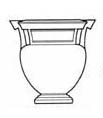 Named for its column-like handles, the column-krater is first known from Corinthian examples dated to the late seventh century. It is regularly produced by Athenian potters from the first half of the sixth-century until the third quarter of the fifth. It seems from graffiti on Athenian red-figure examples that the vessel was referred to as Korinthios or Korinthiourges.
Named for its column-like handles, the column-krater is first known from Corinthian examples dated to the late seventh century. It is regularly produced by Athenian potters from the first half of the sixth-century until the third quarter of the fifth. It seems from graffiti on Athenian red-figure examples that the vessel was referred to as Korinthios or Korinthiourges. 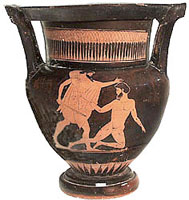
- Athenian red-figure column-krater ht. 35cm.
Calyx-krater
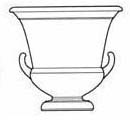 The handles of the calyx-krater are placed low down on the body, at what is termed the cul. Their upward curling form lends the shape an appearance reminiscent of the calyx of a flower, hence the name. The earliest known example was possibly made by Exekias in the third quarter of the sixth century. It continues to be produced, mainly in red-figure, becoming more elongated over the course of the fifth and fourth centuries.
The handles of the calyx-krater are placed low down on the body, at what is termed the cul. Their upward curling form lends the shape an appearance reminiscent of the calyx of a flower, hence the name. The earliest known example was possibly made by Exekias in the third quarter of the sixth century. It continues to be produced, mainly in red-figure, becoming more elongated over the course of the fifth and fourth centuries.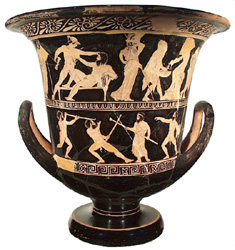
- Athenian red-figure calyx-krater ht. 39.5cm
Bell-krater
 The latest of the four krater-types, it first occurs in the early fifth century, and is not found decorated in black-figure. It is named for its bell-like shape, perhaps originating in wood. It has small horizontal upturned handles just over halfway up the body. Some do not have a foot, and earlier examples may have lugs for handles. Over the course of the fifth and fourth centuries, the shape becomes slimmer.
The latest of the four krater-types, it first occurs in the early fifth century, and is not found decorated in black-figure. It is named for its bell-like shape, perhaps originating in wood. It has small horizontal upturned handles just over halfway up the body. Some do not have a foot, and earlier examples may have lugs for handles. Over the course of the fifth and fourth centuries, the shape becomes slimmer.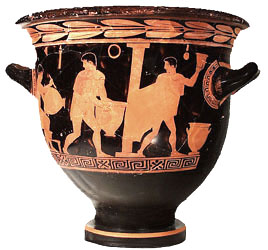
- Athenian red-figure bell-krater ht. 35cm.
Volute-krater
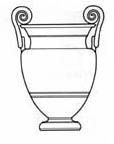 The volute-krater is named after its handles. The François Vase is a famous and early example, but the typical Athenian form occurs only later in the sixth century, with the handles tightly curled so that they look like the volutes on Ionic columns. The shape is also found in metal. Over the course of the fifth and fourth centuries, examples become slimmer, and Apulian volute-kraters from South Italy are particularly elaborate.
The volute-krater is named after its handles. The François Vase is a famous and early example, but the typical Athenian form occurs only later in the sixth century, with the handles tightly curled so that they look like the volutes on Ionic columns. The shape is also found in metal. Over the course of the fifth and fourth centuries, examples become slimmer, and Apulian volute-kraters from South Italy are particularly elaborate. 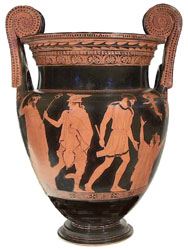
- Athenian red-figure volute-krater ht. 46.5cm.
Amphorae
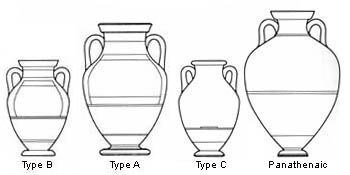
The amphora (pl. amphorae; from Greek amphi - on both sides, phero - carry) is a two-handled pot with a neck that is considerably narrower than the body. It was used for the storage of liquids and solids such as grain. Undecorated 'coarse' amphorae, with their lower part tapering to a point, were the standard transport containers in the Mediterranean. They are frequently depicted in symposium scenes. Panathenaic prize amphorae are perhaps the closest in shape, but the majority of painted amphorae are grouped into two main types, the one-piece belly-amphorae, and neck-amphorae, which have a clearly-marked neck. Also discussed here is the pelike, another two-handled storage vessel.
Panathenaic prize amphora

The broad body, narrow neck and foot of Panathenaic amphorae gives a shape reminiscent of transport amphorae. They served as prizes in the Panathenaic Games, containing oil for victors. The Games seem to have been established in Athens in the 560s, and the earliest examples of the shape can be dated to around the same time. Panathenaic amphorae are useful for dating, since they continue to be produced well after the fourth century, becoming more elongated and elaborate. From the fourth century, the name of the archon for the year is inscribed, permitting an unusually precise means of fixing chronology.
Panathenaic amphorae are only decorated in the black-figure technique. Athena always appears on one side, with the inscription "ton Athenethen athlon" - a prize from Athens. The event for which the vase was a prize is depicted on the other side
Amphorae 'of Panathenaic shape' refer to vases of this shape that are decorated in different ways, such as those in red-figure. Smaller versions also occur, perhaps as souvenirs.
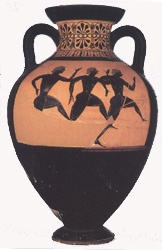
- Athenian amphora ht. 49.5cm. Panathenaic shape
Belly amphora
The belly-amphora has a continuous profile from lip to foot. It is usually lidded.
Type B amphora
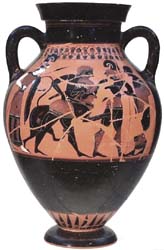
The most typically occurring form is termed Type B, characterised by the combination of round handles, the mouth's straight lip, and the convex profile of the one-piece foot (termed 'echinus'). The shape is old, dating back to the seventh century, and continuing to be produced until the mid-fifth century.
Type A amphora

During the third quarter of the sixth century, a new, more elaborate type is introduced. Type A amphorae are recognisable by their flat, flanged handles, often decorated with ivy, and two-part ('stepped') foot.
Type C amphora
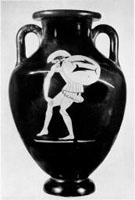 A third type, Type C, is less common. Like Type B it has a one-piece foot, but the lip is round ('torus') rather than straight.
A third type, Type C, is less common. Like Type B it has a one-piece foot, but the lip is round ('torus') rather than straight. Pelike
 The Greek term pelike (pl. pelikai) was used for a number of shapes, and we do not know what this one-piece vessel with a distinctive sagging belly was called in antiquity. It seems to have been invented after the introduction of the red-figure technique, although there are examples in black-figure. It continues to be produced into the fourth century. It is shown in use as a container for liquids.
The Greek term pelike (pl. pelikai) was used for a number of shapes, and we do not know what this one-piece vessel with a distinctive sagging belly was called in antiquity. It seems to have been invented after the introduction of the red-figure technique, although there are examples in black-figure. It continues to be produced into the fourth century. It is shown in use as a container for liquids.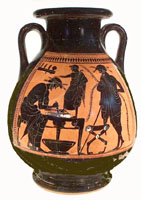
- Athenian black-figure pelike ht. 38cm
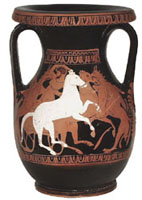
- Athenian red-figure pelike 4th century ht. 28cm
Neck-amphora
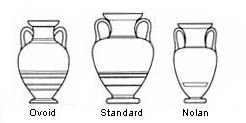
The neck-amphora is identifiable by its clearly defined neck. The shape is old, recognisable among Geometric and Protoattic vases. In Athenian black-figure, examples can be ovoid (notably the so-called Tyrrhenian amphorae, which seem to have been made for an Etruscan market), but the standard type has a more obvious 'shoulder', perhaps inspired at some stage by East Greek shapes. Another distinct type is the strap-handled Nikosthenic amphorae. These imitate a shape found in Etruscan bucchero, and the find-spots suggest that an Etruscan market was intended.
Neck-amphorae continue to be decorated with the black-figure technique, but later examples (from c.500) are often smaller. Those with double-reeded handles are termed 'doubleens'. Among the various types found in red-figure, distinctive are the small Nolan amphorae, identifiable by their high necks, and named after Nola where many examples were found.
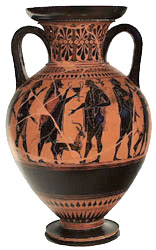 Athenian ovoid ht. 40cm.
Athenian ovoid ht. 40cm.
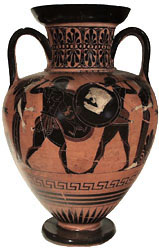 Athenian standard ht. 38cm.
Athenian standard ht. 38cm.
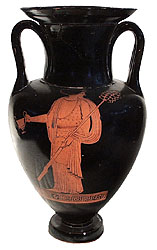 Athenian red-figure Nolan ht. 32cm.
Athenian red-figure Nolan ht. 32cm.
Other vessels for carrying liquids
Gathered here are further vessels that were used for carrying and storing liquids. All can be seen in use on Athenian painted pottery. The lebes is differentiated today from kraters, although it too could have been used as a mixing vessel. A particular form, the lebes gamikos, is regularly found in contexts associated with marriage. Another vessel for liquid that is found in the context of religious ritual is the loutrophoros.
Two further shapes - one old, one new - are important liquid-holders. The hydria, identified by its three handles, two horizontal and one vertical, and the stamnos, possibly of Etruscan derivation.
Stamnos
 The stamnos (pl. stamnoi; possibly connected with Greek histemi - I set up) is a broad-shouldered, round-shaped vessel, with a low foot and a low neck. Its two horizontal handles usually curl upwards to some degree. It is produced from the late sixth century into the later fifth. Most have been found in Etruria. The name might have been used for this shape in antiquity, but not necessarily exclusively, and it may also have been applied to other storage vessels, such as amphorae.
The stamnos (pl. stamnoi; possibly connected with Greek histemi - I set up) is a broad-shouldered, round-shaped vessel, with a low foot and a low neck. Its two horizontal handles usually curl upwards to some degree. It is produced from the late sixth century into the later fifth. Most have been found in Etruria. The name might have been used for this shape in antiquity, but not necessarily exclusively, and it may also have been applied to other storage vessels, such as amphorae. Some examples have lids, suggesting that they were used for storage. From illustrations of the shape in use, it is clear that stamnoi could also be used for the serving of liquids, and may be considered alongside lebetes and kraters.
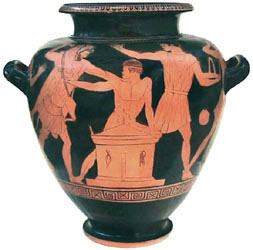
- Athenian red-figure stamnos ht. 35.5cm
Hydria
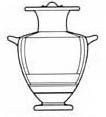 An old shape, with precursors in the eighth century, the hydria (pl. hydriai; compare Greek hudor - water) is a water-jar with three handles, two for carrying and one for pouring. The application of the name to the shape is reasonably certain, although such vessels were not only used for the carrying of water. We know, for example, that hydriai held votes in ballots and ashes in cemeteries.
An old shape, with precursors in the eighth century, the hydria (pl. hydriai; compare Greek hudor - water) is a water-jar with three handles, two for carrying and one for pouring. The application of the name to the shape is reasonably certain, although such vessels were not only used for the carrying of water. We know, for example, that hydriai held votes in ballots and ashes in cemeteries. 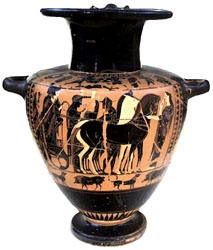
- Athenian black-figure hydria ht. 48cm
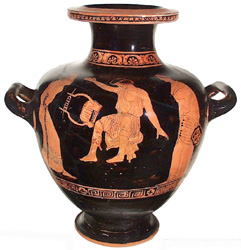
- Athenian red-figure hydria ht. 27cm.
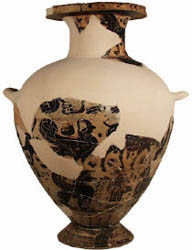
- Early black-figure shape
The hydria is found in a variety of forms in black- and red-figure, as well as in metal. In early black-figure, examples are round-bodied, with horizontal handles about halfway up. By the mid-sixth century, the sharply-shouldered type has been developed, often decorated in three zones - the shoulder, the body and the predella.
Examples are found in red-figure as well as black-, but the more typical red-figure shape is round-shouldered. It was invented in the late-sixth century, and over the course of fifth and fourth centuries becomes slimmer, and its handles more tightly curled. The Greek term kalpis (pl. kalpides) is often used today for this version, although it is not clear whether it had the same association in antiquity.
Loutrophoros
 The loutrophoros (pl. loutrophoroi) is an ovoid-bodied vessel with a tall neck and two or three handles (hence the terms loutrophoros-amphora and loutrophoros-hydria), used for carrying and storing water. Examples can be traced back to the eighth century. The use of the term 'loutrophoros' for vessels of this shape is modern; in antiquity it probably referred to the person responsible for carrying the water (Greek loutron - water for bathing, phero - to carry).
The loutrophoros (pl. loutrophoroi) is an ovoid-bodied vessel with a tall neck and two or three handles (hence the terms loutrophoros-amphora and loutrophoros-hydria), used for carrying and storing water. Examples can be traced back to the eighth century. The use of the term 'loutrophoros' for vessels of this shape is modern; in antiquity it probably referred to the person responsible for carrying the water (Greek loutron - water for bathing, phero - to carry).
The illustrations on vases regularly suggest the settings in which the vessel was used - marriage and funerary rituals - and excavated examples, as well as images of the shape on other vases, support these contexts. Later in the fifth century, the shape was carved in marble for Athenian cemeteries.

- Athenian black-figure loutrophoros (restored) ht. 40cm. approx
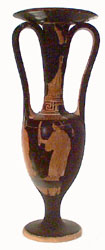
- Athenian red-figure loutrophoros ht. 26cm.
Pouring vessels
A range of pottery shapes could be used to distribute liquid from a large mixing bowl. These fall under the term oinochoe; the olpe and chous are modern sub-categories. There were no doubt alternatives in other media - some vases show a long-handled ladle being used - and some of the pottery shapes, or certain features, can be paralleled in metalwork. Also considered here is the kyathos, a single-handled ladle-like vessel.
Oinochoe, olpe and chous
The term oinochoe (pl. oinochoai; Greek oinos - wine and cheo - I pour) is appropriate to this shape and illustrations of it in use, and appears to have been used in antiquity. It is a single-handled vessel, usually taller than it is wide. Beazley identified ten types, based on variations of profile, mouth-type - such as trefoil (like an ivy leaf), round or beaked - and handle-form. One such is the chous (pl. choes), a plump shape with a smooth profile and trefoil mouth. Miniature versions are often found in children's graves, invariably decorated with scenes involving young children. They were probably used in Athens during the Anthesteria. On the second day of the festival, named Choes, the newly-opened wine was drunk.
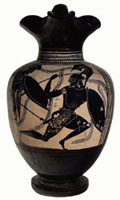
- Athenian black-figure oinochoe (Type 1) ht. 24.5cm.
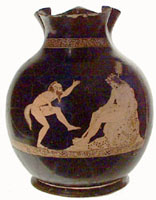
- Athenian red-figure oinochoe (Type3 - chous) ht.21.5cm.
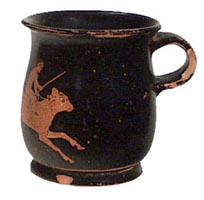
- Athenian red-figure oinochoe (Type 8 - mug) ht. 9.5cm.
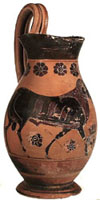
- Attic black-figure olpe (Type 2) ht. 33cm
The olpe (pl. olpai) is distinguished today from oinochoai. It is tall in relation to its breadth, with a smooth profile and a high handle. Examples occur from early on in black-figure. The name is ancient, but there seems to be little basis for applying it to this particular form. The 'oinochoe of Type 8' may also be called a mug in modern literature, after its spoutless rim and short size, and may have been used for drinking. Like other oinochoe-types, it may also have served as a measure.
Kyathos
Developed in the second half of the sixth century, most probably in the workshop of Nikosthenes, the kyathos (pl. kyathoi; compare the Greek verb, kuein - 'to contain') is a small dipper, with a single high handle and low foot. It seems that the shape was copied from Etruria, and, like the Nikosthenic amphorae, serves as a likely example for the targeting of a particular market by Athenian potters. The name seems to be correct for this shape, although it also occurs as a measure.
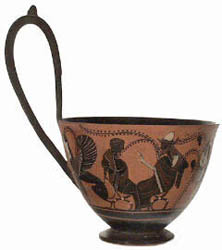
Cups and other drinking vessels
Consistent features for drinking cups during the sixth to fourth centuries B.C. are the relatively shallow shape, a foot that is connected to the bowl by a stem (except in the case of stemless cups) and two handles. The Greek name kylix (pl. kylikes) seems to have been used for the shape in antiquity, although it was probably applied to other drinking vessels too. Modern classifications such as Komast-, Siana-, Little Masters, and Types A, B, and C are useful for bringing to light the general course of the shape's development, which is broadly chronological. But not every example fits neatly into each type, and scholars have identified further variants, such as Cassel and Droop cups. In all cases, the handles are horizontal, often swinging upwards. Handles that meet at a point, such as those found on so-called Merrythought cups, are named 'wishbone handles'after the skeletal feature that they resemble.
Deeper vessels, such as the skyphos, mastos and kantharos, are also considered here, as are the rhyton, head- and figure-vases. Many are depicted in use, most obviously in symposium scenes. In particular, the kylix is used for the game of kottabos, which involved flinging the dregs of one's drink at a target. 'Mugs' are discussed under pouring vessels, but phialai are included here, for they were occasionally used as drinking vessels.
Cups
Komast cup
Siana cup
 Named after a site on Rhodes where examples were found, Siana cups can be distinguished from Komast cups by their taller feet and lips. They are decorated on the interior (the tondo), another difference from Komast cups, and there are two schemes for decorating the exterior. The 'double-decker' type involves two friezes on each side, one on the lip (usually floral), and a figured scene on the body. The 'overlap' type uses a single frieze on each side to cover the total height of the body and lip. Aspects of the form and decoration of Siana cups appear to be indebted to East Greek models.
Named after a site on Rhodes where examples were found, Siana cups can be distinguished from Komast cups by their taller feet and lips. They are decorated on the interior (the tondo), another difference from Komast cups, and there are two schemes for decorating the exterior. The 'double-decker' type involves two friezes on each side, one on the lip (usually floral), and a figured scene on the body. The 'overlap' type uses a single frieze on each side to cover the total height of the body and lip. Aspects of the form and decoration of Siana cups appear to be indebted to East Greek models.Little Master cup
The term 'Little Master cup' is a translation of the German Kleinmeisterschale, alluding to the small scale of the decorative elements. It has a high-stemmed foot and an offset concave lip. Examples are divided into two categories; lip-cups and band-cups.Although there are differences of shape - the lip is more obviously offset on a lip-cup than on a band-cup - the most obvious distinction is in the scheme of decoration. Band-cups are painted black save for the handle zone, which contains a decorated frieze, whereas lip-cups are largely plain save for the line that divides the lip and the body. In the handle-zone there is often an inscription and occasional decorative elements, while the lip may carry a single figure (often a bust) or a small group.
Type A cup
Type B cup
Type C cup
Stemless cup
Images of cups
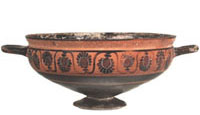
- Komast Cup ht. 11 cm.
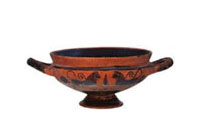
- Small proto-Siana cup ht. 6cm
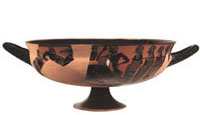
- Siana Cup - Overlap ht. 14cm.
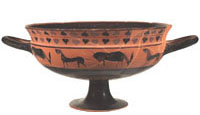
- Siana Cup - Double decker ht. 14.5cm
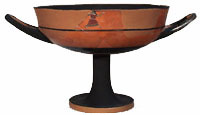
- Lip Cup ht. 10cm.
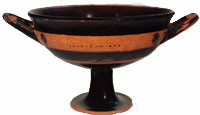
- Band Cup ht. 11.5cm.
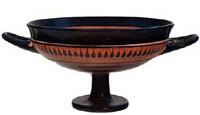
- 'Droop' Cup ht. 12cm.

- Cup of Type A ht. 12cm.
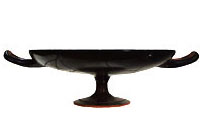
- Cup of Type B ht. 8cm
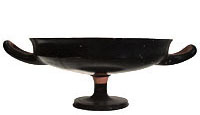
- Cup of Type C ht. 9.5cm.
Skyphos, mastos and mastoid cup

The skyphos (pl. skyphoi) is a deep-bowled drinking vessel with a low foot and two short handles that are usually horizontal. It is regularly depicted in symposium scenes. Shallower versions of the shape, with a concave lip, are termed 'cup-skyphoi'. In the fifth-century, some skyphoi have a vertical handle. These are regularly decorated with an owl, an Athenian symbol, from where the name glaux (Greek for owl) is derived.
The term skyphos is ancient, although it seems also to have been used for cups (kylikes). Another term that is often used for deep straight-sided drinking vessels is the Greek kotyle (pl. kotylai), but this too seems to have been used in antiquity for cups of all sorts. Likewise, kylix also seems to have been used to refer to the shape we today term the skyphos.
A variation on the shape, the mastos (pl. mastoi; Greek mastos - breast), is named for its breast-like shape, which terminates in a nipple. Examples with a flat base and offset lip are termed 'mastoid cups'.

- Corinthian skyphos

- Large Athenian black-figure cup-skyphos
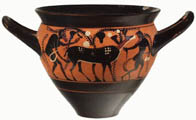
- Athenian mastoid cup
Kantharos

The kantharos (pl. kantharoi) is a deep vessel with two distinctive high handles. The stem of the foot is often tall. The form can be traced back to the eighth century, and kantharoi - perhaps metal versions- are frequently depicted on black- and red-figure vases, held by Dionysos or Herakles. Although the name is ancient (Greek kantharos - dung-beetle), it is not clear how precisely it was connected with this shape, and it seems that kotyle could have been used as well.
In the fourth century, the 'cup kantharos' is common. Its handles project horizontally, and do not return to join the body.
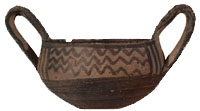
- Boeotian kantharos ht. 7cm
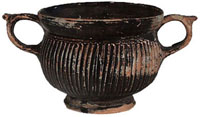 Boeotian black kantharoid cup - skyphos ht. 7cm
Boeotian black kantharoid cup - skyphos ht. 7cm
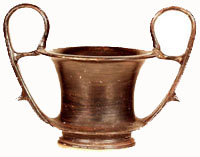 Black kanthoroid trick vase ht. 12cm
Black kanthoroid trick vase ht. 12cm
 Boeotian red-figure kantharos ht. 20cm
Boeotian red-figure kantharos ht. 20cm
Rhyton, head-vase and figure-vase
Rhyton (pl. rhyta) is a term applied to a drinking-horn, through which liquid may be poured (compare Greek rhysis - a stream). The shape originates in the Near East, where it may be elaborated by rendering the spout in the form of an animal head. Examples seem to have inspired Athenian potters to make their own versions. In many cases, the animal-head no longer serves as an orifice (the vessel is used as a cup, rather than for pouring), but the term rhyton is often used today nonetheless.
The animal head, such as a ram or mule, is mould-made and attached to the bottom part of the cup. The addition of mould-made heads is not confined to drinking vessels, and neither are the heads only of animals - female, satyr or Negro heads can be found for aryballoi and oinochoai too (these may be termed 'head-vases'). In some cases, two heads may be juxtaposed back-to-back ('janiform'). Occasionally the terracotta attachments may be in the form of complete figures, such as the riding Amazon or Negro mauled by a crocodile associated with Sotades (these are termed 'figure-vases').
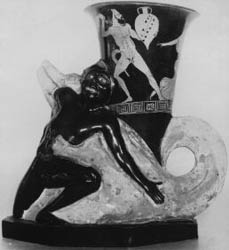
- Athenian figure vase
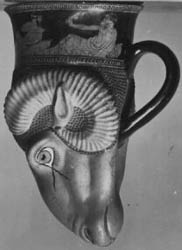
- Athenian figure vase head
Lebes or Dinos
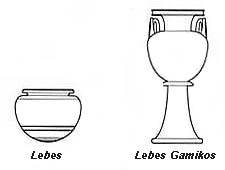 A lebes (pl. lebetes; Greek lebes - bowl) is a deep bowl, usually handleless and with a low neck. The shape is one of the oldest in Athenian black-figure, and continues to be made into the fifth-century. It has no foot, but may be mounted on a stand. In vase-paintings, the shape is shown in use as a mixing-bowl in the symposium. Lebetes are also preserved in metal, and the shape can be incorporated into a tripod. There are many references to lebetes as prizes. The Greek word dinos (pl. dinoi) is sometimes used today for the shape, but is not known securely for it in antiquity.
A lebes (pl. lebetes; Greek lebes - bowl) is a deep bowl, usually handleless and with a low neck. The shape is one of the oldest in Athenian black-figure, and continues to be made into the fifth-century. It has no foot, but may be mounted on a stand. In vase-paintings, the shape is shown in use as a mixing-bowl in the symposium. Lebetes are also preserved in metal, and the shape can be incorporated into a tripod. There are many references to lebetes as prizes. The Greek word dinos (pl. dinoi) is sometimes used today for the shape, but is not known securely for it in antiquity.
A version with upright handles, a lid, a more distinct neck and often made in one piece with the stand is known today as a lebes gamikos (pl. lebetes gamikoi; Greek gamein - to marry). Examples continue to be made into the fourth century. It is usually associated with marriage rituals, both in excavated contexts and as depicted on vases, including the shape itself.
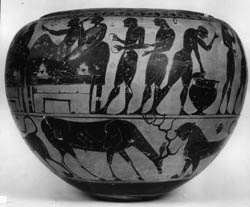
Phiale
Pottery examples of the phiale (pl. phialai) are relatively few. It is a metal shape, and the application of the name to the shallow dish lacking handles is certain. Those with a central depression on the exterior that rises up as a boss in the centre of the bowl are described as mesomphaloi. From depictions of the shape in use - most typically for making libations - we can see that it was held with the palm outstretched and the middle finger reaching into the exterior depression.
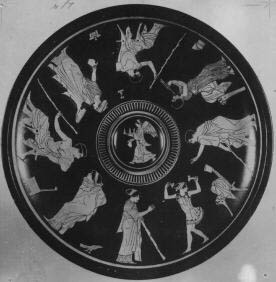
Small closed shapes
Although the range of vessels gathered here is diverse, they all have a similar function as containers for personal use, an impression supported by their depictions on vases and other media. Many are small too, suggesting that they could have held precious commodities, such as (perfumed) oil. The lekythos and aryballos are well-established in early black-figure, and various forms are developed over time. The shape of the alabastron varies little. It only becomes popular among Athenian potters from the mid-sixth century, although earlier examples can be found in Corinthianware. Decorated askoi are preserved only in red-figure, from the early fifth century. Also considered here are a number of shapes, generally without handles, that may be grouped under the terms pyxis and exaleiptron. The latter covers the kothon and plemochoe.
Lekythos
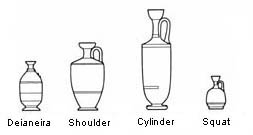
Like the aryballos, in that it has a narrow neck and a single handle, the lekythos (pl. lekythoi) is generally a taller vessel with a small, deep mouth. The Greek word lekythos was undoubtedly used for the various forms considered here, although it does appear that it was used for oil-vessels in general.
In the early sixth-century, the lekythos has an oval-shaped body, but as with the hydria and neck-amphora, a shouldered-type is developed around the middle of the century. This form, with a tapering body, continues to be decorated by black-figure painters. But it is the cylindrical type, first preserved from the last third of the sixth-century, that will be predominant in the fifth century, and it is this form that is decorated with polychrome figures on white-ground. Fragmentary examples (and X-ray photography) reveal that some had a smaller inner chamber, to limit the volume of oil that could be held.
The role of the white-ground (cylindrical) lekythoi in funerary ritual is made clear both by their excavation from cemeteries and their depiction, invariably on lekythoi themselves, standing or fallen over at the graveside. Late in the fifth century, some massive examples of the shape are produced ('Huge Lekythoi'), serving perhaps as equivalents for stone grave-markers.
The broad-footed squat lekythos lacks the sharp shoulder of the cylindrical type. It begins to be made late in the fifth century.
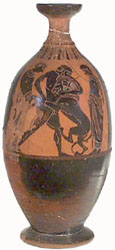
- Deianeira ht. 26.5cm
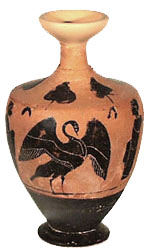
- Shoulder ht. 19cm

- Cylinder ht. 25.5cm
 Squat ht. 10cm
Squat ht. 10cm
Aryballos
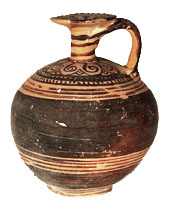
- Athenian aryballos
Aryballoi are common in Corinthian ware, some being tiny and meticulously decorated. Examples are less widespread in Athenian, although the shape is depicted on vases or funerary stelai, either hanging up, often with a strigil or sponge in an athletic setting, or being used by the athletes themselves.
In Corinth and East Greece, warrior's heads, animals, and other mould-made figures could serve as the body of aryballoi. Athenian potters sustain the habit, and there are examples in the form of female heads, shells, even genitals.
Alabastron

- Athenian alabastron ht. 13cm.
Askos
The Athenian askos (pl. askoi) is a small, round vessel with a flat bottom and an over-arching handle that joins the obliquely-angled neck. There is little room for extensive decoration, and often a pair of figures suffices.
The Greek word askos refers to the bags made of animal-skin that were used to carry wine; in Athenian red-figure scenes, they are often depicted in the arms of satyrs. Its modern application to this pottery-shape originates in the supposed similarity of some examples to animal-skins.
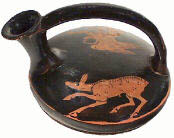
Pyxis and Exaleiptron
 The pyxis (pl. pyxides) is a small round box, probably used for storing trinkets, ointments or cosmetics. The type can be traced back to Geometric examples, which are often topped by horses, but the most common black-figure shape seems to have been borrowed from Corinth. In red-figure, pyxides are regularly decorated with scenes of female activity, and the shape is shown in feminine contexts. Contemporary references to vessels of this sort use the word kylichnis, and the term pyxis is found mainly after the fourth century B.C. However, its connection with the Greek pyxos - boxwood, may reveal something about the shape's material origins, and examples of the shape can be found in other media, such as stone.
The pyxis (pl. pyxides) is a small round box, probably used for storing trinkets, ointments or cosmetics. The type can be traced back to Geometric examples, which are often topped by horses, but the most common black-figure shape seems to have been borrowed from Corinth. In red-figure, pyxides are regularly decorated with scenes of female activity, and the shape is shown in feminine contexts. Contemporary references to vessels of this sort use the word kylichnis, and the term pyxis is found mainly after the fourth century B.C. However, its connection with the Greek pyxos - boxwood, may reveal something about the shape's material origins, and examples of the shape can be found in other media, such as stone.
Another type of container is the exaleiptron (pl. exaleiptra) which may have been used primarily for liquids (compare the Greek exaleipho, - wash over, anoint). It is not entirely clear to which specific shape, if any, the term refers, and in modern literature other Greek names such as kothon or plemochoe may be used.Typical however is the cylindrical form of the body and an incurving lip that would prevent spillage of the contents whilst carrying. In the sixth century, some may have three (often decorated) feet, but later examples tend to have a high splaying foot. They are carried by women as they approach the grave on white-ground lekythoi.
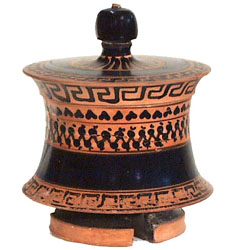
- Athenian pyxis ht. 11cm
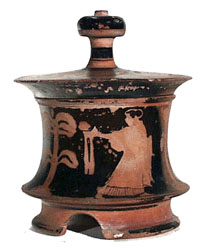
- Athenian pyxis ht. 14.5cm
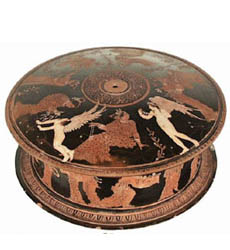
- Athenian pyxis
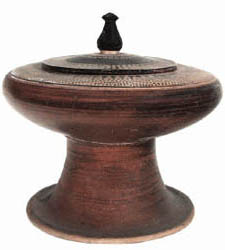
- Exaleiptron
Other shapes
The majority of Athenian painted pottery shapes can be classified under the few headings employed here. There are however some that do not fit so neatly, and these may be grouped together, if only to give a flavour of the range of forms outside the standard core. A selection includes the following: lekanis/lekane, plate and epinetron.
Other painted shapes include:
- bobbins
- eggs
- louteria
- lydia
- plaques
- phormiskoi
- stands
http://www.beazley.ox.ac.uk/pottery/shapes/default.htm